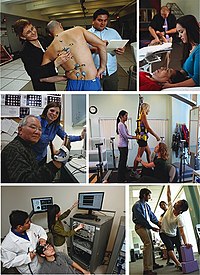
Photo from wikipedia
INTRODUCTION Middle Eastern immigrants exhibit high levels of physical inactivity and are at an increased risk for Type 2 diabetes. The primary aim of this study was to examine the… Click to show full abstract
INTRODUCTION Middle Eastern immigrants exhibit high levels of physical inactivity and are at an increased risk for Type 2 diabetes. The primary aim of this study was to examine the changes in objectively assessed physical activity levels following a culturally adapted lifestyle intervention program. The secondary aim was to examine the association between objectively assessed physical activity and insulin sensitivity. STUDY DESIGN RCT conducted over 4 months in 2015. PARTICIPANTS Iraqi immigrants residing in Malmö, Sweden, exhibiting one or more risk factors for Type 2 diabetes. INTERVENTION The intervention group (n=50) was offered a culturally adapted lifestyle intervention comprising seven group sessions including a cooking class. The control group (n=46) received usual care. MAIN OUTCOME MEASURES Raw accelerometry data were processed by validated procedures and daily mean physical activity intensity, vector magnitude high-pass filtered (VM-HPF), was inferred. Further inferences into the number of hours/day spent in sedentary (VM-HPF <48 milli-Gs [mGs] where G=9.8 m/sec2) and light- (48- <163 mGs); moderate- (163- <420 mGs); and vigorous-intensity (≥420 mGs) activities were also calculated (year of analysis was 2016-2017). RESULTS No difference was observed between the two groups in terms of change over time in VM-HPF. There was a significant increase in the number of hours/day spent in light intensity physical activity in the intervention group compared with the control group (β=0.023, 95% CI=0.001, 0.045, p=0.037). The intervention group also increased the time spent in sedentary activities, with the highest VM-HPF (36- <48 mGs) within the sedentary behavior (B=0.022, 95% CI=0.002, 0.042, p=0.03). Higher VM-HPF was significantly associated with a higher insulin sensitivity index (β=0.014, 95% CI=0.0004, 0.025, p=0.007). CONCLUSIONS The findings favor the culturally adapted intervention approach for addressing low physical activity levels among Middle Eastern immigrants. Replacing sedentary time with light-intensity activities could be an achievable goal and will have potential beneficial effects for diabetes prevention among this sedentary group of immigrants. TRIAL REGISTRATION This study was registered at www.clinicaltrials.gov NCT01420198.
Journal Title: American journal of preventive medicine
Year Published: 2018
Link to full text (if available)
Share on Social Media: Sign Up to like & get
recommendations!